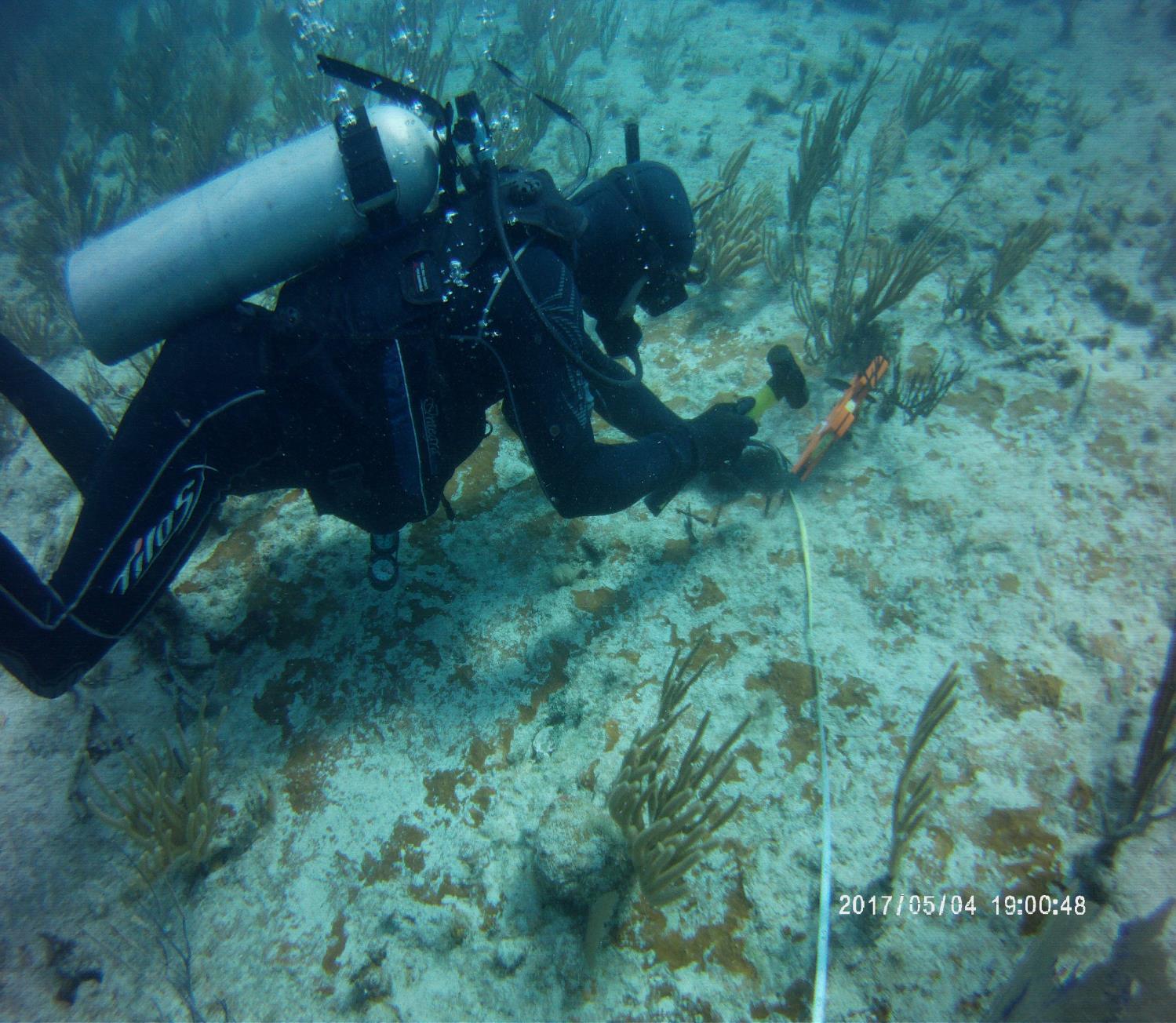
Final Report
Restoration of two threatened populations of Acropora cervicornis in eastern Puerto Rico: using a quantitative demographic model to guide the ir management
11/15/2019
Restoration of two threatened populations of Acropora cervicornis in eastern Puerto Rico: using a quantitative demographic model to guide their management
PI- Elvira Cuevas, PhD Center for Applied Tropical Ecology and Conservation, University of Puerto Rico
Co -PI Alex E. Mercado-Molina, PhD
Sociedad Ambiente Marino
-Results and findings
Population status of A. cervicornis: Size-Structure: As previously reported by Mercado -Molina et al. (2015a), the population size structure differed significantly between the study areas (D=0.224, p < 0.025). At CLP, 68% of the individuals measured <100 cm compared to 53% at PAL (Fig. 1). The population at PAL also displayed a broader size range than colonies at CLP. Colonies at PAL reached sizes as large as 545 cm, whereas, at CLP, only one colony surpassed 298 cm. Indeed, large colonies (<250 cm) were more common at PAL, where they comprise about 22% of the population. At CLP, large colonies accounted for only 10% of the colonies measured. As expected by the observed sizefrequency distribution, median size differed significantly, with colonies being markedly larger at PAL (Mann- Whitney U-test, p < 0.003, CLP: mean 83.88: median 65.44: PAL: mean: 134.02: median 96.02; Fig.2). Temporal differences in size - frequency distributions were detected at the two sites (CLP: D=324; p < 0.0001; PAL: D=334; p < 0.0001.). Congruent with our previous arguments (Mercado-Molina et al., 2015a), we observed that populations are currently shifting toward smaller populations dominated by small- sized colonies (≤100 cm). In 2013, small colonies comprised about 50% of the population at CLP compared to 68% in 2017. Similarly, at PAL, the proportion of small colonies increased from 44% in 2013 to 53% in 2017. There was also a considerable reduction in the number of large colonies (≥250 cm). Large colonies decreased by 16% (26% in 2013 to 10% in 2017) and 15% (from 37% in 2013 to 22% in 2017) at CLP a nd PAL, respectively. Colony size, however, differed between years at CLP but not at PAL (Fig. 2). With the data on size -frequency distribution, we updated the population trajectories at the study sites following the population model we previously developed (Mercado -Molina et al., 2015a). Results confirmed our previous findings that both populations can face extinction in about ten years (Fig. 2).
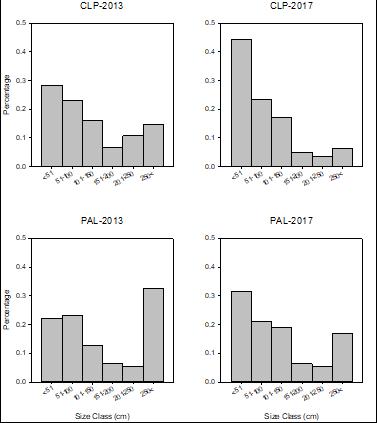

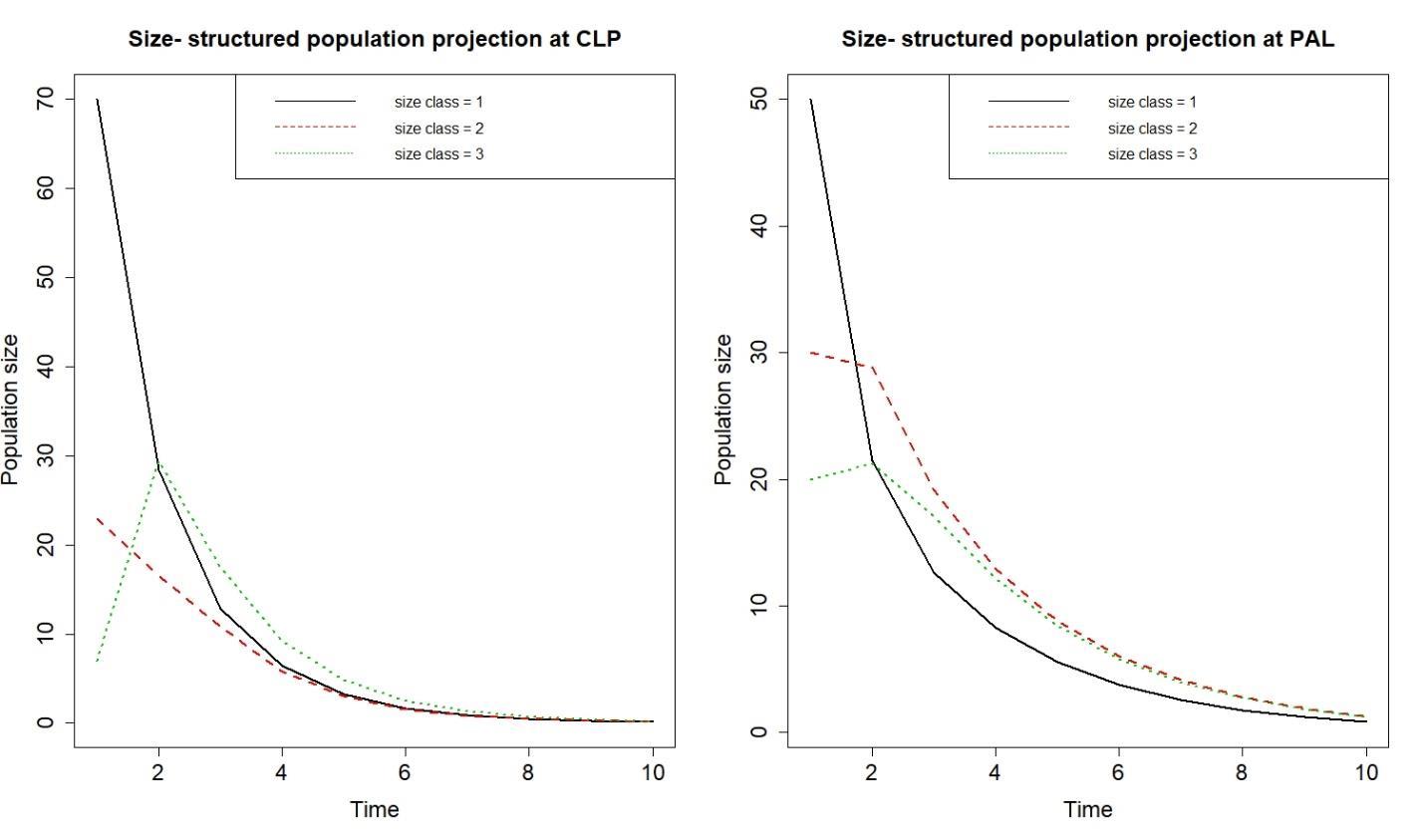
Figure 2: Projections of population size over time at Canal Luis Pena (CLP) and Palomino (PAL) updated wi th the data on size-frequency distribution and abundance collected at the study sites during the initial part of the project. Projections based on the demographic model developed by Mercado-Molina et al. (2015). Size class 1= Colonies ≤ 100 cm total in linear length; Si ze class 2 = 101-250 cm in total linear length; Size class 3 = Colonies ≥ 250 cm in total linear length.
Population density and Spatial temporal Colony condition : Partial mortality differed sign ificantly between sites. (Fig. 3). In general, colonies at CLP were in poorer conditions than colonies at PAL. At CLP, 60% of the colonies have lost over 20% of their live tissues compare to only 30% at PAL. The mean calculated partial mortality values were 40% (median 38%) and 17% (median 14%) at CLP and PAL , respectively. The proportion of colony suffering partial mortality increased from 48% to 60% at CLP between 2013 and 2017. On the contrary, at PAL the proportion of colony that have lost tissue decreased from 45% to 30%. The reduction in the number of co lonies affected by tissue loss may be related to the mortality of the colonies with more than 20% of partial mortality. The number of colonies with partial tissue loss at CLP in 2017 was significant higher than that during 2013 (Mann- Whitney U-test , p < 0.05). The number of colonies per m2 was much higher at PAL (0.80/m2) than at CLP (0.40/m2). Such difference was statistically significant (Fig. 3; Mann- Whitney U-test, p = 0.06).
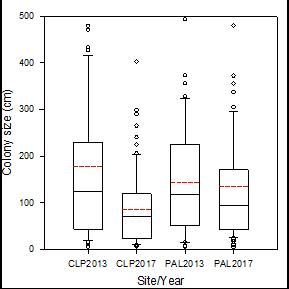
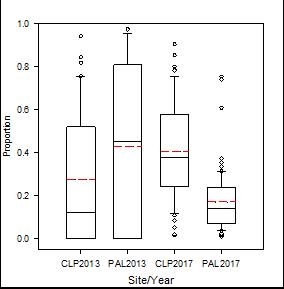
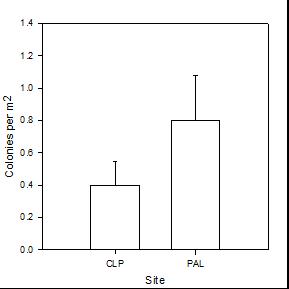
Figure 3. (Right ) Boxplot describing the median (and mean) colony size of Acropora cervicornis at the two sites and the two -time periods. Solid black lines = median. Dashed red line = mean. (Middle) Boxplot describing the proportion of partial mortality in colonies of Acropora cervicornis at the two sites and the two -time periods. Solid black lines = median. Dashed red line = mean. (Right) Mean colony density of Acropora cervicornis. Bar = Standard Error
Mercado -Molina et al. (2018) developed a demographic model that takes into consideration the population- level effect of partial mortality. Their results indicated that partial mortality could have a detrimental effect on population growth rate when 50-75% of the colonies show over 20% of total tissue loss. In this sense, it can be argued that the population at CLP is at a higher risk of extinction than the population at PAL. Based on Mercado -Molina et al. (2018), we updated the population projections at the study sites taking into consideration colonies with 20% or more of tissue loss. The model indicates that, on average, CLP is losing colonies 2.4 times faster than PAL (Fig. 4).
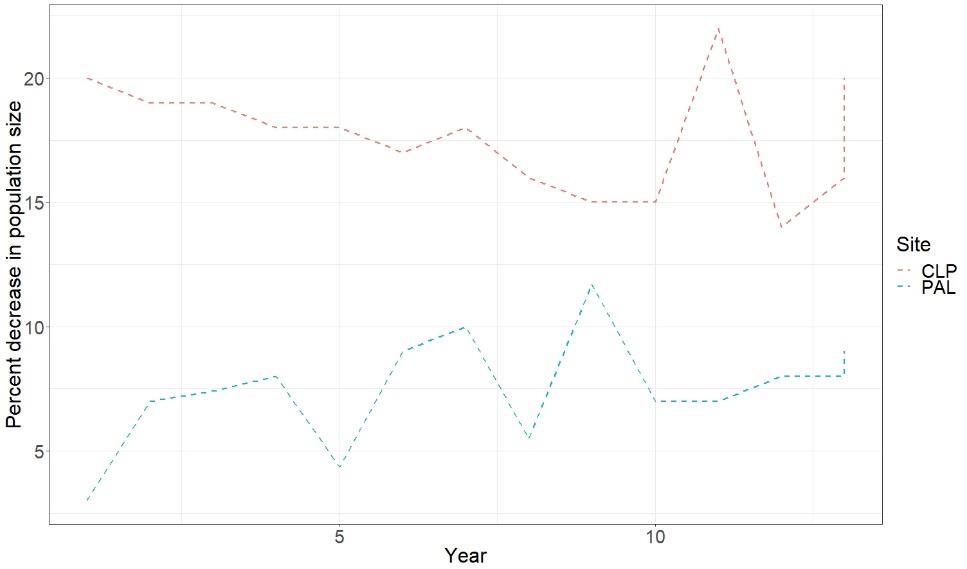
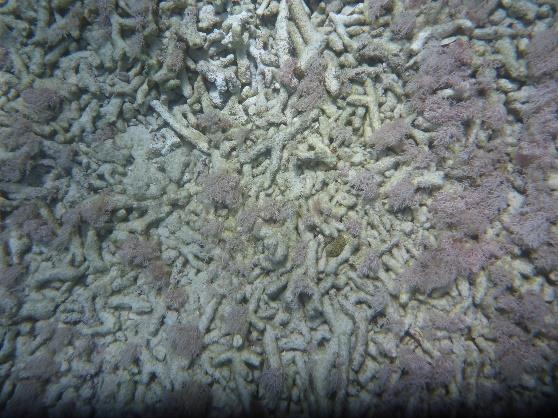
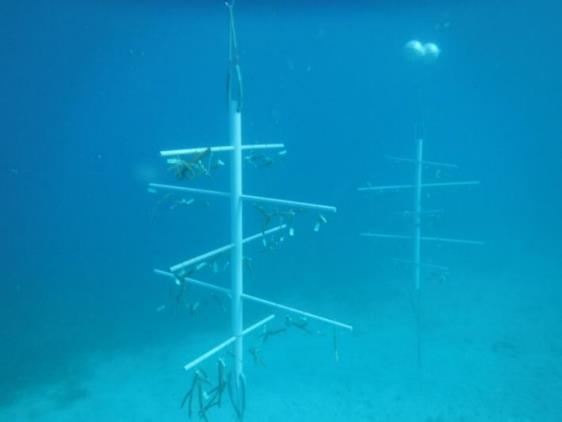
The impact of Hurricanes Irma and María: Hurricanes Irma and María devastated most of the coral reefs across the Northeastern coast of Puerto Rico (Toledo -Hernandez et al. 2018, pers. observations; Fig. 5). Our study sites were not an exception. Approximately 95% of the wild colonies that were tagged for the demographic study died. Likewise, we lost 100% of the colonies that were outplanted as part of our restoration effort. The loss of the colonies was a significant setback for the fulfillment of the proposed objectives; there were very few wild coral colonies alive to study the demography of A. cervicornis and to determine the populations level response to assisted recruitment (e.g., coral outplants). Our sole option was to star over the whole process of restoration. The first step was to establish new coral nurseries to propagate the species until reaching a considerable number of colonies with the adequate size to be transplanted to the reefs (Fig.5). To set the coral nurseries, we searched for hurricanes-generated fragments across Culebra. One hundred fragments, 50 from Culebrita and 50 La Ahoga, were fou nd. The coral colonies were split into three smaller pieces. One of the fragments was placed at one of two nursery units located Punta Soldado (PSOL), and the other one, in one of two nursery units at Tamarindo (TAM). Hence, coral nurseries at PSOL and TAM consisted of 100 coral fragments, 50 from each region. By splitting the fragments, we correct ed for possible genetic effects on the demographic performance The remaining fragments were transplanted to a patch reef in PSOL to test the hypothesis proposed by Sleeman et al. (2005) that coral cover will increase faster when the spatial arrangement of corals outplants is uniform. Currently, we are collaborating with the Environmental Epigenetics Laboratory at Florida International University to determine colon y-specific genetic composition.
Growth and survival of coral fragments growing in coral nurseries: The demographic performance of the fragments growing in the coral nurseries was followed for nine months. We found that survival rates varied significantly between localities (TAM: 47%; PSOL: 69%; Chi-square test = 9.05, p = 0.003; Fig. 6). TAM is a locality exposed to higher sedimentation rates during raining events due to its proximity to a deforested land area (personal observation). There is evide nce indicating that high sedimentation rates have an adverse effect on coral demographics, which may explain the lower survival rates at this site. Interesting, at TAM, the survival of the coral fragments depended on the site of origin. Colonies from La Ah oga were two times more likely to die than colonies from Culebrita (Chi-square test = 10.277; p = 0.001; Fig. 1). In contrast, at PSOL colonies from Culebrita and La Ahoga showed similar survival rates (Culebrita: 70%; La Ahoga 2: 68%; Chi-square test = 0, p = 1). These results indicate that the survival of coral colonies may depend not only on the prevailing environmental conditions of the site to which coral is transferred but also on the intrinsic properties of the colonies (e.g., genetics).
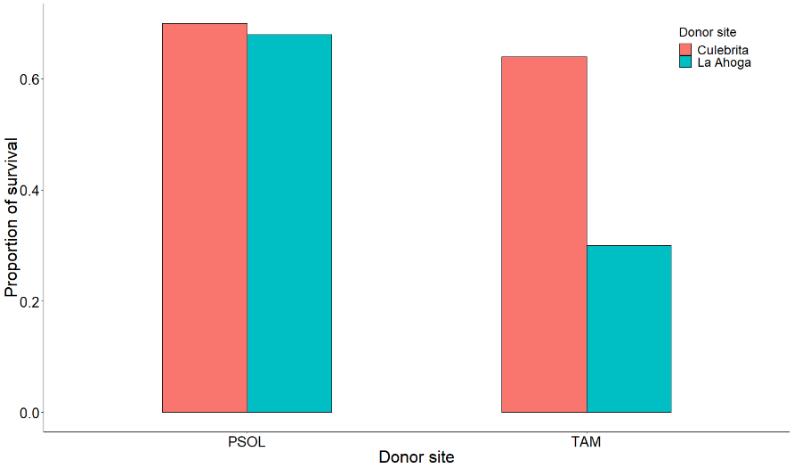
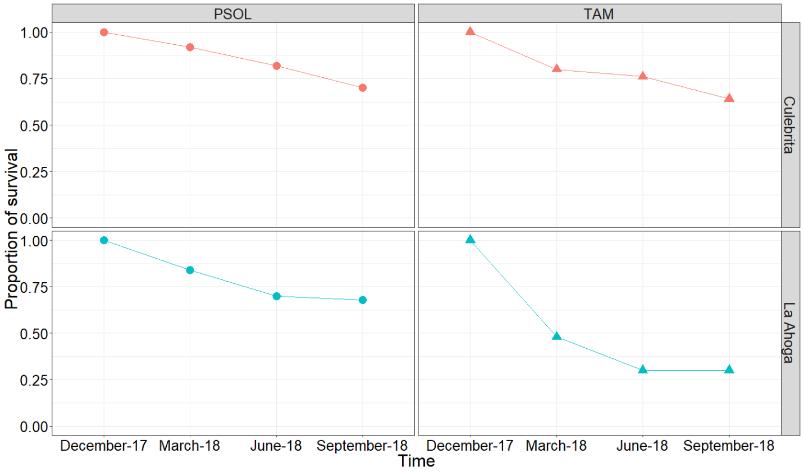
Growth rates at TAM differed significantly between donor sites (MannWhitney U-test, p < 0.05), with colonies from Culebrita gr owing faster than the colonies from La Ahog a: 0.68±0.20 cm year-¹ (±SD) and 0.56±0.21 cm year-¹ (±SD), respectively. In contrast, there was no significant difference in growth rate between the donor sites at PSOL: fragments from Culebrita grew at 0.67±0.16 cm year-¹ (±SD) whereas fragments from Culebrita grew at 0.68±0.28 cm year-¹ (±SD) fragments from La Ahogá (Mann- Whitney U-test , p > 0.05).
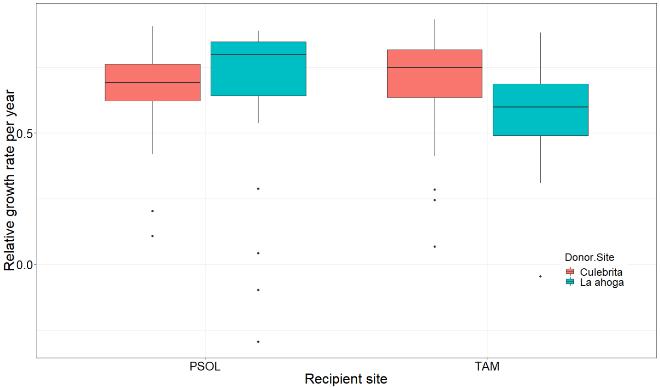
Growth and Survival of coral fragments outplanted to two reefs in Culebra : At the two study sites, growth rates did not differ between local and foreign coral outplants, as shown in Figure 5, (PSOL: Mann- Whitney Utest , p-value is .299947; TAM: Mann- Whitney U-test , p-value =.182787). Mean growth rates were 3.22±4.07 cm month-¹ (±SD) and 3.63±2.67 cm month-¹ (±SD) for local and foreign out plants, respectively at PSOL whereas at TAM mean growth rates was 2.07±1.59 cm month-¹ (±SD) and 2.44±2.08 cm month-¹ (±SD) for locals and foreign outplants, respectively. When comparing the performance of fragments grown at TAM it was found that those outplanted at PSOL grew significantly faster than those outplaned at the site of origin (Mann- Whitney Utest , p-value < 0.05). In contrast , colonies grown at PSOL per formed better when outplanted at the site of origin (Mann- Whitney U-test, p-value < 0.05). After one year, close 95% of transplants were alive at the two sites.
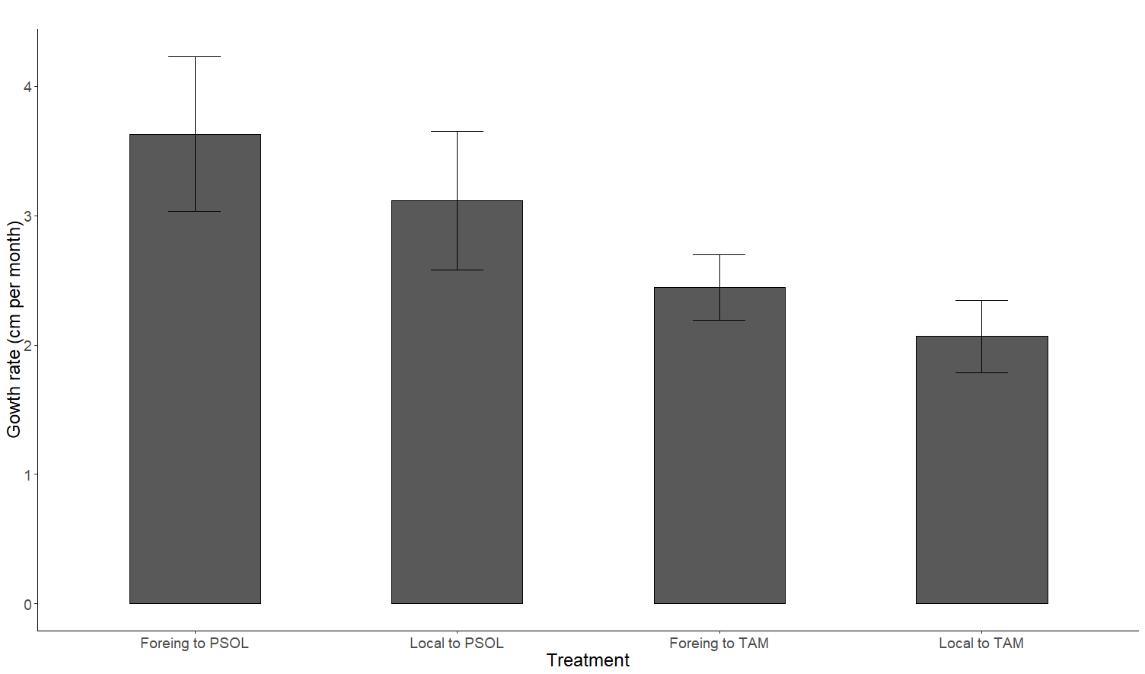
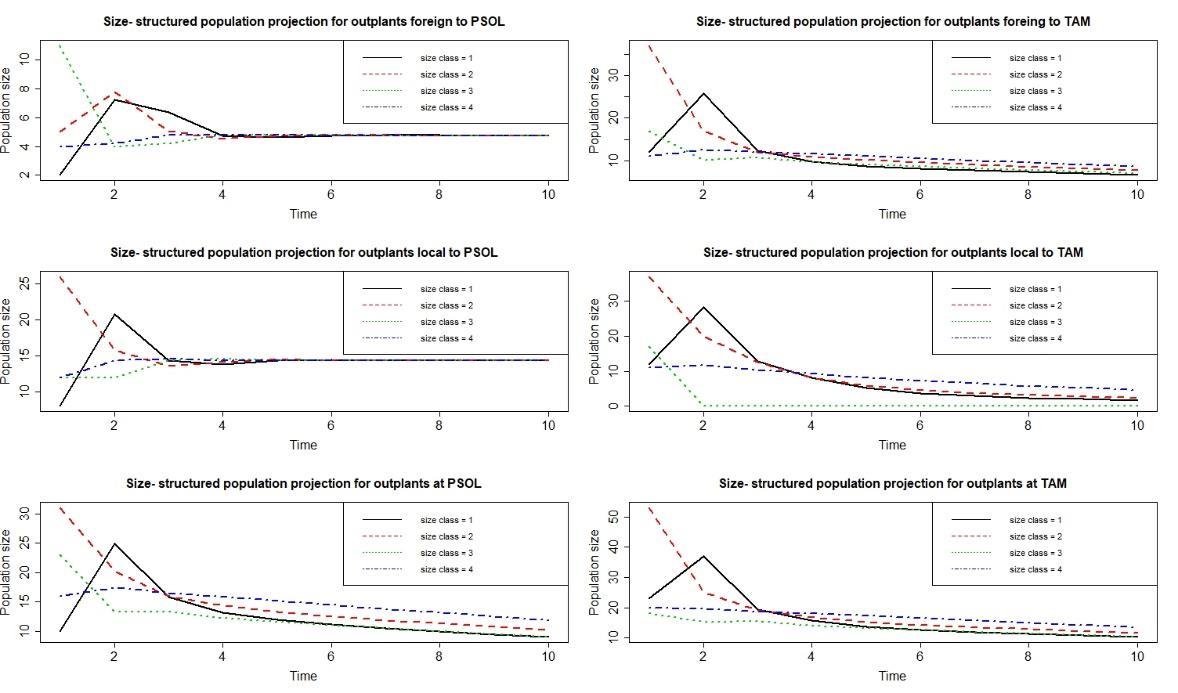
Demographic performance of the restored populations: One of the objectives of the study was to validate the population matrix model developed by Mercado -Molina et al. (2015a) for populations of A. cervicornis. To do this, we run the model with the demographic data obtained from the coral outplants at TAM and PSOL. Figure 9 shows the results of population projections at each of the sites. Both populations are decreasing as the estimated population growth rates were 0.98 at PSOL and 0.95 at TAM. Population growth rates below stability (value < 1) is not surprising due to the lack of sexual and asexual recruitment within the restored populations. These findings support our previous argument that both sexual and asexual recruitment are rare; and, therefore, do not contribute to local population growth. The model also confirms that in the absence of periodic human intervention (e.g., outplanting) restored population can face extinction in about ten years; even when survival rates exceed 95%.
5 | Page
Study Sites: The first part of this study was carried out at Canal Luis Peña (CLP) and Palomino (PAL) reefs. CLP (18°18’14’’N, 65°20’15’’ W) is located within the Canal Luis Peña No -Take Marine Reserve on the isla ndmunicipality of Culebra, approximately 30 km east of the Puerto Rico mainland. PAL (18°21’3’’ N, 65°33’58’’W) is located within La Cordillera Natural Reserve 6 km from the coastal municipality of Fajardo. The reef structure at both sites has a northeast orientation and is exposed to the easterly trade winds and long period swells during the winter. Consequently, both sites are frequently exposed to moderate to intense wave action. Water quality is good (e.g., very low turbidity, no terrigenous sediments) as none of the sites are directly influenced by river-derived sediment, nutrient discharges, or coastal development. At the two sites, A. cervicornis colonize what used to be an A. palmata dominated zone, currently characterized by low topographic relief and dominated by octocorals. Because the two populations were extirpated by the impacts of Hurricanes Irma and María and the many logistical constraints in the aftermath of the Hurricanes the continuation of the project (i.e., coral nurseries and site restoration) was performed at Punta Soldado (PSOL) and Tamarindo (TAM) reefs in Culebra. These sites were chosen because populations of A. cervicornis were also threatened to extinction (Mercado -Molina et al., 2015b) and because the local NGO Sociedad Ambiente Marino (SAM) helped to cover the costs not anticipated as a result of the hurricanes. PSOL and TAM have an active nursery and restoration project run by t he local SAM. The sites are characterized by low wave energy, and relatively good water quality (mean horizontal water transparency 7.7 m, Ruiz -Ramos et al. 2011). No differences in temperature or water transparency are evident between sites (Hernández -Delgado and Suleimán- Ramos, Sociedad Ambiente Marino, unpublished data). The area of transplantation is of low topographic relief (Mercado -Molina et al. 2015c) with a consolidated bottom where Millepora spp., Diploria spp. and Porites spp. visually dominate macrofauna. However, macroalgae cover is higher at PSOL (≈37%) compared to TAM (≈17%).
Demographic monitoring: Pre-hurricanes data were collected from 100 naturally occurring (not coral transplants) colonies at each CLP and PAL at 3 -5 m depth. Colonies were considered dead if no live tissue was distinguishable. Colony size was estimated by adding the size of the lengths of all live portions of branches. To do this, a set of photographs was taken in situ from different angles (scale-by- side) (Mercado -Molina et al. 2015 a, b), which allowed us to measure all branches fully extended. This approach is an accurate estimate of the actual colony size of A. cervicornis, as demonstrated by Mercado -Molina et al. (2015b). The free license software CPCe® version 4.1 was used to make all measurements. The density of A. cervicornis at CLP and PAL was estimated by counting all colonies found within five 25m2 quadrats.
Restoration: After the impact of Hurricanes Irma and María, the focus of the project shifted towards propagating the species. The effect of the Hurricanes on the natural populations was devasting, with less than 5% of wild colonies surviving. All outplants disappeared. The first step was to establish coral nurseries at PSOL and TAM. We collected 100 colony fragments that survived the impact of the Hurricanes. The corals were split and placed on coral nurseries at each of the sites, for a total of 200 colonies. The fate o f the coral fragments was followed for nine months. Survival and growth were estimated, as explained above. Following the time in the nurseries, colony branches were collected and transplanted to each of the reefs using nails and cables ties. In total, 100 colonies were outplanted at each of the sites. Colonies were stabilized directly to the substrate using concrete nails of 8 cm (length) and plastic cable ties (Garrison and Ward 2008; Hollarsmith et al. 2012; Mercado -Molina et al. 2015b). Coral transplant s were tagged with a numbered cable tie, and their survival and growth were followed for a year every six months; some of the outplants lost their tags after intense wave surge associated with many tropical storms that affected the Caribbean during the study.
Statistics: Two -sample Kolmogorov-Smirnoff test was used to determine whether the size- frequency distribution of A. cervicornis differed between the two study sites. We also compared the observed population structures with our data from 2013 to evaluate any possible temporal changes. The non-parametric Mann- Whitney U-test was used to compare median colony size between populations as well as between years (2013 vs. 2017). MannWhitney U-test was also used to compare the condition of the colonies, i.e., percent of tissue loss and population densities. Chi-square was used to determine whether the survival of colonies growing in nurseries differed between locations and between sites of origin. Mann- Whitney U-test was used to compared colony r ates of growth both during the nursery phase and once the colonies were outplanted to the reefs. The demographic data (survival and growth) was used to parametrize a matrix population model following (Mercado -Molina et al., 2015a). The model allowed users to simulated population trajectories over ten years.
-Objectives
Objective 1: The main goal of this project was to restore two populations of A. cervicornis in northeastern Puerto Rico that could go extinct in ten years without human intervention.
Objective 2: Validate the population matrix model developed by Mercado -Molina et al. (2015a).
-Other products: N/A
-List PI’s supported PI- Elvira Cuevas, PhD
Man- month effort: 1.13;
Amount paid from both SG and Match: $0.00 Co -PI Alex E. Mercado-Molina, PhD Man- month effort: 1.13;
Amount paid from both SG and Match: $0.00
-List students supported
Name Email
Yanelle Silva ym-silvaluna@live.com
Ivanna Ortiz ivanna2051@gmail.com
Degree working toward Time and effort
Category # of new students # of continuing students # of degrees awarded
Sea Grant
Supported PhD
Sea Grant
Supported MS/MA
Sea Grant
Supported BA/BS 2 2
Other
One student graduated in May 2019 One student is expected to graduate in May 2020
-List thesis and dissertations from students supported by the project
Yanelle Silva Luna: Undergraduate “Tesina”: Acropora cervicornis as a model specie to test the Local Adaptation theory: implications for restoration ; May 2019
-List presentations, technical reports and special awards. (Send copies when available)
1. Relationship between partial mortality and the demography of the threatened coral Acropora cervicornis. Presented at the benthic meeting in Texas by Yanelle Silva
2. Variación espaciotemporal en la pérdida de tejido en el coral amenazado Acropora cervicornis. Presented at the International Conference MarCuba. By Jaime Fonseca
3. Tissue loss rather than colony size determines colony fate in Acropora cervicornis. Presented at the International Conference MarCuba by Alex E. Merca do -Molina
4. Does preconditioning of coral fragments to local environmental conditions improve the demographic performance of Acropora cervicornis outplants? Presented at the AMLC Meeting in Punta Cana in May by Javier Rodriguez.
5. Acropora cervicornis as a model specie to test the Local Adaptation theory: implications for restoration. By Yanelle Silva. Undergraduate Symposiu m University of Puerto Rico -Río Piedras.
6. Does the spatial configuration of coral outplants affect c oral growth and survival? Presented at the AMLC Meeting in Punta Cana in May by Jaime Fonseca.
7. Does preconditioning of coral fragments to local environmental conditions improve the demographic performance of Acropora cervicornis outplants? An updated version of the pr esentation 5. To be presented at the 14th International Coral Reef Sympos ium Bremen, Germany by Samiris Suleimán.
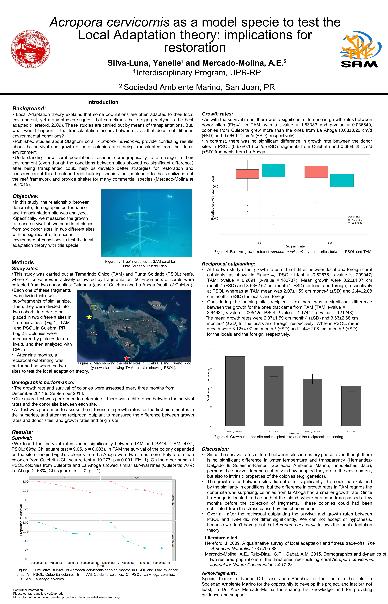
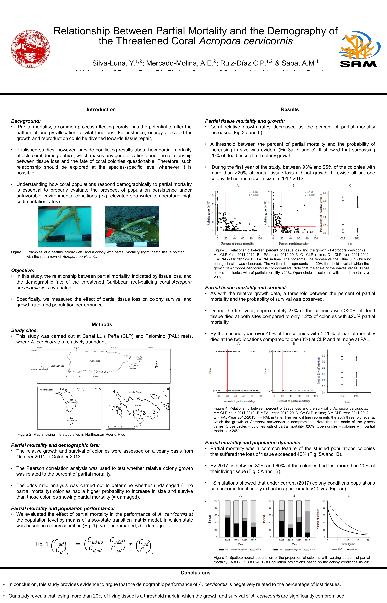
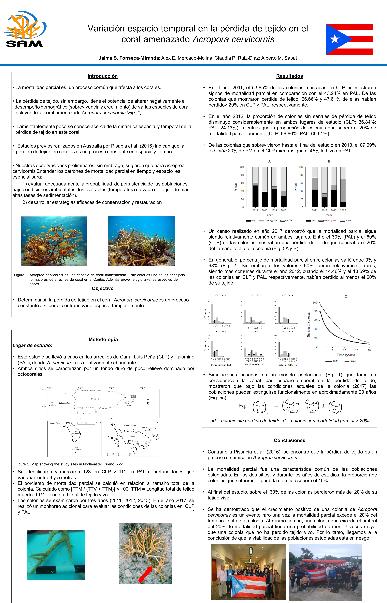
-List references for, books, chapters, and peer reviewed publications, in press, and submittals. : As we are in the final process of the data analysis, we have not published our work yet. Two articles are expected.
RECAP – The current threatened status of A. cervicornis is of great concern because it is one of the dominant reef-building corals in the Caribbean. Our results are congruent with our previous arguments that populatio ns in northeastern Puerto Rico are currently shifting toward smaller populations dominated by small- sized colonies (≤100 cm), which are usually characterized by lower demographic performance. It was also confirmed that the viability of the restored populations is not grant ed with the populations facing functional extinction within ten years. Our results highlight once more time that human intervention is needed to revert such a pattern.
RELEVANCE
‐ Studies directed at understanding the population dynamics of A. cervicornis have been relatively scarce. Moreover, documented studies have focused on estimating rates of colony growth, survival, and recruitment, but none has evaluated how variations in demographic rates (e.g., survivorship, growth, and
8 | Page
recruitment) affect the pop ulation growth (λ) of A. cervicornis restored populations. Indeed, in 2005, the Acropora Review Team identified the lack of demographic data and models as one of the principal impediments to better understand the prospect of A. cervicornis recovery. More t han ten years later, such demographic data and modeling tools are still in need (NFWS, 2015). Effective conservation and management initiatives cannot be achieved without a proper understanding of the population dynamics of the targeted species. At the same time, conservation management strategies often depend on predictions of population biology (dynamics), which can be only achieved through demographic modeling. The quantitative tools we employed, as well as the model developed, provided the baseline demo graphic data necessary to develop educated conservation and management plans with the primary goal of assisting the recovery of A. cervicornis in Puerto Rico.
RESPONSE - Provide an action statement. Consider: What did this project do?
None of the restoration projects focused on A. cervicornis have been firmly grounded on quantitative demographic analyses (e.g., Mercado -Molina et al. 2015a). Moreover, the few population studies have focused in estimating rates of colony growth, survival, and recruitment (Bowden-Kerby, 2001; Garrison and Ward, 2008; Hollarsmith et al. , 2012) but none has evaluated how variations in demographic rates (e.g., survivorship, growth, and recruitment) affect the population growth (λ) of A. cervicornis restored populations. The lack of proper demographic data hinders the effectiveness of restoration efforts because initiatives intended to improve the persistence of a population may fail to target those vital rates that have the greatest contribution to λ. Indeed, the lack of demographic modeling tools has been identified as an area of concern (NOAA Acropora Biological Review Team, 2005; NFWS, 2015). This research focuses on addressing such a gap. The results of this project: First: validated the population matrix model we developed, thereby providing a quantitative tool that scientists and managers can use to develop conservation and restoration strategies intended to promote the recovery of A. cervicornis. Second: confirmed that coral nurseries and outplanting are feasible approaches to propagate the species. Third: validated our argument that outplanting colonies at least 25 cm in colony size is an effective initial size of transplantation. Therefore, this research project provided critical demographic information to develop educated management and conservation plans for one of the most important and threatened Caribbean corals, a key goal of the University of Puerto Rico Sea Grant Program.
Who were the principal partners, collaborators, contributors? This project was a collaborative effort between the Center for Applied Tropical Ecology and Conservation and the local NGO Sociedad Ambiente Marino.
What were the key elements? The results of this study will be incorporated into the restoration strategies that SAM is planning for the near future.
Who was the target audience? The target audiences of this project were the scientists, local stakeholders, and environmental organizations that are working in coral conservation and restoration projects thro ugh the Caribbean.
RESULTS: First: The establishment of in-situ coral nurseries to propagate the species, which was much in need after the impacts of Hurricanes Irma and María. Second: Two populations of A. cervicornis were established in areas where the Hurricanes extirpated wild populations. Therefore, the project has increased the probability of A. cervicornis persistence across Culebra. Third: The population model developed by Mercado -Molina et al. (2015a) was validated. The model can be used to perform future demographic analyses that can allow us to a) identify the demographic parameter responsible for differences in population growth between locations, time, and restoration treatments; b) determine which life stage is more sensitive to site -specific restoration activities; c) identify the life transition that contributes the most to local population growth which will provide an insight to where local management effort should be focused; d) identify of the minimum size and numbers of coral outpla nts needed to keep populations stable. Thus, the results of this work have provided baseline information that can be incorporated into management and conservation plans. Furthermore, the model can be useful for other species
9 | Page
with a similar life cycle, especially the more than 100 congeneric species that are among the most rapidly declining corals in the world; i.e., the Caribbean coral Acropora palmata which is also listed as a threatened species. Finally, the model can be used for formulating hypo theses and testing them experimentally. Additionally, the resulting models will be published so all interested individuals can make used of it to answer specific management and conservation questions. Fourth: The integration of students and citizen scientists generated environmental awareness among members of the community.
References :
ABRT (Acropora Biological Review Team) (2005) Atlantic Acropora status review document. Report to National Marine Fisheries Service, Southeast Regional Office, 152 pp.
Bowden-Kerby, A. (2001). Low-tech coral reef restoration methods modeled after natural fragmentation processes. Bulletin of Marine Scienc e, 69(2), 915-931.
Garrison, V. H., & Ward, G. (2012). Transplantation of storm-generated coral fragments to enhance Caribbean coral reefs: A successful method but not a solution. Revista de Biología Tropical, 60, 59 -70.
Hollarsmith, J. A., Griffin, S. P., & Moore, T. D. (2012, July). Success of outplanted Acropora cervicornis colonies in reef restoration. In Proceedings of the 12th International Coral Reef Symposium A (Vol. 20, pp. 1-5)
Mercado-Molina, A. E., Montañez -Acuña, A., Rodríguez -Barreras, R., Colón-Miranda, R., Díaz -Ortega, G., Martínez-González, N., ... & Sabat, A. M. (2015) c. Revisiting the population status of the sea urchin Diadema antillarum in northern Puerto Rico. Journal of the Marine Biological Association of the United Kingdo m, 95(5), 1017-1024.
Mercado-Molina, A. E., Ruiz -Diaz, C. P., & Sabat, A. M. (2015) b. Demographics and dynamics of tw o restored populations of the threatened reef-building coral Acropora cervicornis . Journal for Nature Conservation, 24, 17-23.
Mercado-Molina, A. E., Ruiz -Diaz, C. P., & Sabat, A. M. (2018). Tissue loss rather than colony size determines the demographic fate of the branching coral Acropora cervicornis . Marine Ecology Progress Series, 597, 147-159.
Mercado-Molina, A. E., Ruiz -Diaz, C. P., Pérez, M. E., Rodríguez -Barreras, R., & Sabat, A. M. (2015) a. Demography of the threatened coral Acropora cervicornis : implications for its management and conservation. Coral Reefs, 34(4), 1113-1124.
NMFS (National Marine Fisheries Service) (2015) Recover y plan for elkhorn (Acropora palmata) and staghorn (A. cervicornis) corals. Prepared by the Acropora Recovery Team for the National Marine Fisheries Service, Silver Spring, Maryland
Ruiz-Ramos, D. V., Hernández -Delgado, E. A., & Schizas, N. V. (2011). Population status of the long -spined urchin Diadema antillarum in Puerto Rico 20 years after a mass mortality event. Bulletin of Marine Science, 87(1), 113-127. Sleeman, J. C., Boggs, G. S., Radford, B. C., & Kendrick, G. A. (2005). Using agent‐based models to aid reef restoration: enhancing coral cover and topographic complexity through the spatial arrangement of coral transplants. Restoration Ecology, 13(4), 685-694.
Toledo-Hernández, C., Ruiz -Diaz, C. P., Hernánd ez-Delgado, E. A., & Suleimán-Ramos, S. E. (2018) Devastation of 15- year old Community-based Coral Farming and Reef-restoration Sites in Puerto Rico by Major Hurricanes Irma and María Caribbean Naturalist.58, 1-9.
